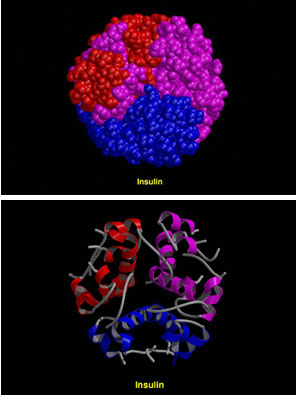What is diabetes?
Diabetes is a condition where the amount of glucose in the blood is too high because the body cannot use it properly.
The full name for this disorder is diabetes mellitus. The disorder is more commonly known as diabetes and this will be used throughout the resource.
Contents
Regulating blood glucose
Two hormones are involved in the regulation of glucose in the blood: insulin and glucagon. Both are produced by specialised cells in the islets of Langerhans in the pancreas .
Diabetes is triggered when a person stops producing insulin or their body does not respond to it normally.

These computer graphics show the structure of insulin. It is a complex protein hormone
Image courtesy of: T. Blundell & N. Campillo / Wellcome Images
How to use this site
There are a number of interactive features in this e-source:
- A glossary of terms: any word with a glossary entry is highlighted like this.
- Quick questions: at the end of most pages or sections there is a question or set of quick questions to test your understanding.
(C 6 H 10 O 5 ) n , that is stored in the liver and in muscles and can be converted back into glucose when needed by the body.













